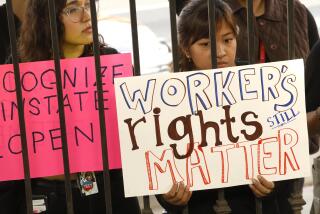Shopping aplenty on the Mall
- Share via
WASHINGTON — Sharon Damon had visited before to tour the exhibits on crafts and culture, but it was another pursuit that brought her back to the National Museum of the American Indian this week: Christmas shopping.
The Annandale, Va., resident hoped to find distinctive gifts for two friends. “The female has a tendency to really be into American Indian things,” Damon said as she browsed among books, blankets, jewelry and artwork, “and I knew that I could specifically get things that are American Indian-oriented.”
Damon settled on a $30 multicolored bound journal for the woman. For her male friend, she cradled a $12 book titled “Native Wisdom,” but she wasn’t quite ready to commit.
With Christmas and Hanukkah just a week away, the seasonal search for the right present is in full swing -- and some of the greatest boutiques in the land are in the gift shops in Smithsonian Institution museums along the Mall.
Where but the Museum of Natural History, for instance, could you find a stocking stuffer such as the grape lollipop with a real cricket encased in the candy ($2)? Is there a more authentic place than the Air and Space Museum to purchase freeze-dried astronaut ice cream, a 6-inch replica of the space shuttle ($13) or a 1/200th-scale model of the Saturn V rocket ($240)? And how many stores offer the type and variety of merchandise found at the American Indian museum, where you can get a $700 silver bracelet by David Neel, an artist of Kwakiutl descent, or a $7.50 wood flute marked “hand made in Chile”?
The Smithsonian, which has more than 20 million visitors a year, is a national federal museum and research organization with 18 museums and galleries as well as the National Zoo. About 70% of its budget comes from the government, with a federal appropriation of $621 million this year.
The 28 museum shops, however, operate with private funds and are an important economic engine for the Smithsonian, generating sales of $49 million in the most recent fiscal year. Profits from business ventures -- including Smithsonian magazine, museum cafes and Imax theaters and a mail-order catalog -- account for nearly half the Smithsonian’s $50 million to $60 million in unrestricted funds, to be spent any way it pleases.
Some of the merchandise offered in museum stores has been developed exclusively for the Smithsonian. Many items come with a note card explaining their history or significance.
The biggest business is done at the Air and Space and the American Indian museums, said Linda St. Thomas, a Smithsonian spokeswoman. American Indian, in particular, got off to a blazing start when it opened in September 2004, bringing in more than $1 million in sales its first week. (It grossed about $8.6 million its first year.)
“The simple math is that Air and Space has the most visitors, so that always stays high,” St. Thomas said. “The Indian museum has two pretty fabulous shops. My guess is they’ll continue to do great, but it’s very hard to beat NASM with the foot traffic in there.”
St. Thomas declined to provide annual sales by museum, saying that doing so “sets up sort of an artificial competition between them.”
The emphasis on commercial activities has upset some of the Smithsonian’s scholars, who say such efforts are a poor fit with the institution’s mission to collect and preserve the nation’s stories and accomplishments.
The holidays are the slow season for the Smithsonian shops. More than half of all sales are rung up between April and July, when millions of tourists and children on vacation swarm over the Mall. As a result, Smithsonian Business Ventures, the division that runs the museum shops, does little to target the holiday shopper.
(In contrast, the online operation, SmithsonianStore.com, trumpets “guaranteed Christmas delivery” and features a $295 miniature Victorian Christmas tree with silk chenille branches.)
More to Read
The biggest entertainment stories
Get our big stories about Hollywood, film, television, music, arts, culture and more right in your inbox as soon as they publish.
You may occasionally receive promotional content from the Los Angeles Times.










